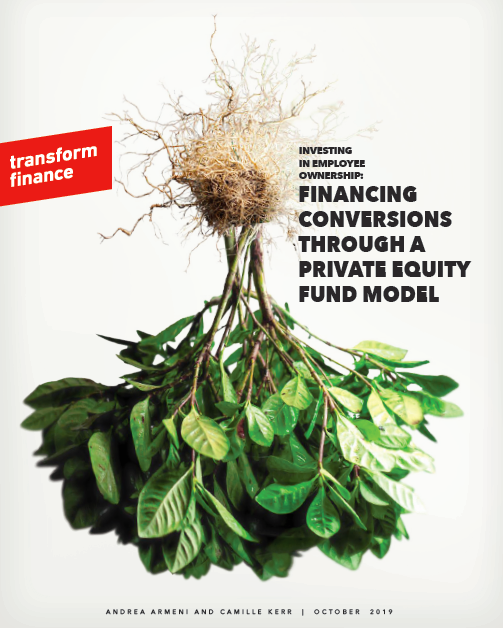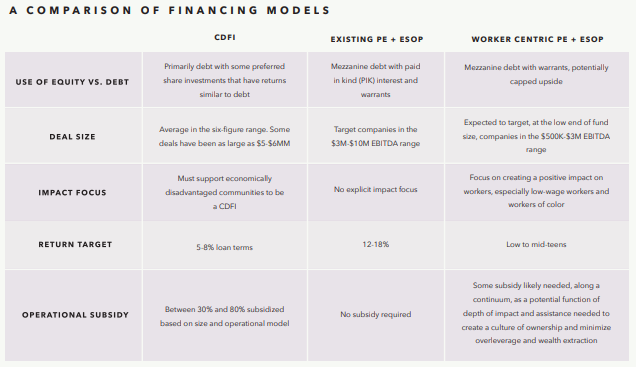Proposed model could provide a vehicle for investors to finance worker-centric employee ownership conversions
by Karen Kahn

In a new paper, “Investing in Employee Ownership: Financing Conversions through a Private Equity Model,” Transform Finance proposes a private equity fund model to finance and scale employee ownership conversions in a worker-centric way. Transform Finance is a nonprofit “working towards a world where capital is aligned with social justice values and serves as a tool for real, transformative social change.” The proposed fund model is intended to serve as a vehicle for impact investors who seek to address economic inequality or the racial wealth gap by building economic security for low-wage workers or workers of color. By centering the impact for low-wage workers and people of color, the model differs from existing fund models that use a private equity structure to finance employee ownership.
The vehicle would resemble the traditional private equity model but its ultimate purpose would be to vest ownership in the workers.
Employee ownership, authors Andrea Armeni and Camille Kerr argue, is a realistic way to address the urgent need for “asset-building opportunities for workers,” a solution to the growing wealth gap, if done in the right way. That includes providing pathways for long-term employee participation, centering people of color and low-wage workers, measuring impact, building employee participation and power, and using non-extractive deal structures. There is evidence of growing interest in this area among investors, as well as a historic market opportunity to increase employee ownership through transitioning ownership of businesses owned by retiring baby boomers (1.2 million businesses with more than 10 employees) to employee ownership.
So what is standing in the way of conversions? The authors note multiple barriers have played a role in the decades-long plateau in employee ownership, including: insufficient awareness about the model, limited access to aligned capital, little incentive for business advisors to recommend it, and questions concerning the impact for employees.
A Nonextractive Investment Vehicle
Their proposal—“a financial vehicle that can acquire companies from exiting owners and shepherd them to employee ownership” and is “grounded in impact considerations and takes an explicit racial and economic justice lens”—is proposed as a way to overcome these obstacles and take employee ownership to scale. The vehicle would resemble the traditional private equity model, in that it would facilitate the sale of the company through a sponsored leveraged buy-out transaction, but its ultimate purpose would be to vest ownership in the workers through an Employee Stock Ownership Plan (ESOP).
There are other differences with traditional private equity. Sponsored leveraged buyouts often seek to increase investor gains by realizing “efficiencies,” which sometimes can mean cutting jobs and dismantling service lines in order to increase the firm’s profitability and, by extension, its exit valuation. As the authors note, “A vehicle that aims to promote employee ownership as a socioeconomic strategy must do so on terms that are fair and conducive to the well-being of the enterprise and the worker owners.”
Investors could expect to receive a return ‘fairly aligned with risk,’ but perhaps not the typical market-rate return of a traditional private equity fund.
The goal, Armeni and Kerr suggest, is to create a “non-extractive” vehicle that leaves more of the value with stakeholders other than investors upon exit. Investors could expect to receive a return “fairly aligned with risk,” but perhaps not the typical market-rate return of a traditional private equity fund.
Filling Gap in Current Financing Landscape
The proposed fund fills a gap in current financing available for employee ownership conversions. In 2017, Mary Ann Beyster, in a paper published by Fifty by Fifty, surveyed the landscape for impact investors interested in employee ownership and found only a few opportunities to invest in employee ownership: 1) a small group of community development finance institutions (CDFIs) focused on worker ownership, and 2) a few private equity (PE) funds using the ESOP model.
As the authors note, the first group, which primarily finances cooperatives, achieves social impact but offers extremely modest returns and, thus, isn’t an easily scalable model. The second group achieves market returns but doesn’t explicitly focus on social impact. The authors also point out that CDFIs are generally small, with less than $30 million in capital. The PE funds investing in ESOP transactions are capitalized at $150 million or more. That gap could be filled by their proposed model, with the entry of one or more funds ranging from $30 million to $150 million, targeting businesses selling in the middle market.
The proposed fund model offers several advantages that, according to the authors, serve to overcome the obstacles that have inhibited the growth of employee ownership:
- It would provide a pool of available capital to be deployed quickly and actively, allowing access to businesses as they come on the market.
- It provides an alternative to sale to a competitor or private equity without necessarily requiring the selling owner to finance the transaction.
- The timeline of the investment matches the period required for a successful conversion, including developing an ownership culture.
- It signals to the current owner that there is organized and capitalized interest in employee ownership, thereby reducing uncertainty about the potential for success.
- It benefits from the learning and shared capacity that a portfolio of companies can provide.
Emerging Mission-Driven Employee Ownership Funds
The authors note that since Beyster’s research in 2017, several mission-driven employee ownership funds have begun to fill the missing space, including the Fund for Employee Ownership at the Evergreen Cooperatives ($20M -$50M), which has received strategic support from The Democracy Collaborative. This and other new or planned funds have different strategies for raising capital (philanthropy, impact investors) and for returns (from concessionary returns to projections of 12-18 percent), but if successful, these funds could provide proof of concept for investors as well as other fund managers considering entering the space.

Guardrails for Positive Social Impact
To ensure that the conversions financed by funds along the proposed model do not lose track of the focus on the positive social impact for workers, the authors propose the following recommendations to guide fund practices:
- Long-term, broad-based employee ownership: Investments are structured to create long-term, broad-based employee ownership.
- Centering people of color and low-wage workers: Investors build a pipeline of companies where employee ownership would generate wealth and agency for low-wage workers and people of color.
- Measured impact: Investors develop and track a set of metrics to measure wealth building, employee social capital, job quality, and other key impact areas.
- Employee participation and power: Transactions are structured to build an ownership culture, engage workers in governance, and implement other pro-worker practices.
- Non-extractive deal structures: Investments are based on a fair valuation and are structured to protect workers from harm, by avoiding practices that, for example, reduce wages and benefits, decertify a union, over-leverage the company with excessive warrants or debt, or otherwise use financial engineering to shift the value of the company to selling owners or management.
With these guardrails in place, Armeni and Kerr make a strong argument for the PE + ESOP model being positioned to compete with, and perhaps begin to crowd out, traditional extractive private equity funds in middle market deals. That outcome would have immeasurably greater social impact by limiting the viability of extractive finance that damages workers and communities—and grows economic inequality.
Karen Kahn provides communications consulting and editorial support for Fifty by Fifty.
To follow Employee Ownership News, subscribe to the Fifty by Fifty newsletter or follow us at Medium.
